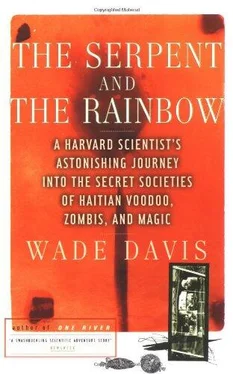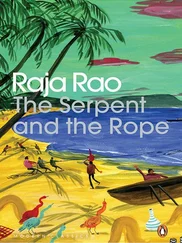Wade Davis - The Serpent and the Rainbow
Здесь есть возможность читать онлайн «Wade Davis - The Serpent and the Rainbow» весь текст электронной книги совершенно бесплатно (целиком полную версию без сокращений). В некоторых случаях можно слушать аудио, скачать через торрент в формате fb2 и присутствует краткое содержание. Год выпуска: 1985, Издательство: Simon & Schuster, Жанр: Старинная литература, на английском языке. Описание произведения, (предисловие) а так же отзывы посетителей доступны на портале библиотеки ЛибКат.
- Название:The Serpent and the Rainbow
- Автор:
- Издательство:Simon & Schuster
- Жанр:
- Год:1985
- ISBN:нет данных
- Рейтинг книги:5 / 5. Голосов: 1
-
Избранное:Добавить в избранное
- Отзывы:
-
Ваша оценка:
- 100
- 1
- 2
- 3
- 4
- 5
The Serpent and the Rainbow: краткое содержание, описание и аннотация
Предлагаем к чтению аннотацию, описание, краткое содержание или предисловие (зависит от того, что написал сам автор книги «The Serpent and the Rainbow»). Если вы не нашли необходимую информацию о книге — напишите в комментариях, мы постараемся отыскать её.
The Serpent and the Rainbow — читать онлайн бесплатно полную книгу (весь текст) целиком
Ниже представлен текст книги, разбитый по страницам. Система сохранения места последней прочитанной страницы, позволяет с удобством читать онлайн бесплатно книгу «The Serpent and the Rainbow», без необходимости каждый раз заново искать на чём Вы остановились. Поставьте закладку, и сможете в любой момент перейти на страницу, на которой закончили чтение.
Интервал:
Закладка:
The latest, according to Lehman, was a woman, Natagette Joseph, aged about sixty, who was supposedly killed over a land dispute in 1966. In 1980 she was recognized wandering about her home village by the police officer who, fourteen years before, in the absence of a doctor, had pronounced her dead.
Another was a younger woman named Francina Illeus but called “Ti Femme,” who was pronounced dead at the age of thirty on February 23, 1976. Before her death she had suffered digestive problems and had been taken to the Saint Michel de l’Attalaye Hospital. Several days after her release she died at home, and her death was verified by a local magistrate. In this case a jealous husband was said to have been responsible. There had been two notable features of Francina’s case—her mother found her three years later, recognizing her by a childhood scar she bore on her temple; and later, when her grave was exhumed, her coffin was found to be full of rocks.
Then, in late 1980, Haitian radio reported the discovery near the north coast of the country of a peculiar group of individuals, found wandering aimlessly in what appeared to be a psychotic state. The local peasants identified them as zombis and reported the matter to the local authorities, whereupon the unfortunate party was taken to Cap Haitian, Haiti’s second city, and placed under the charge of the military commandant. Aided in part by an extensive media campaign, the army had managed to return most of the reputed zombis to their home villages, far from where the group had been found.
“These three instances,” Lehman remarked, “while curious, were still no more substantial than many others that had periodically surfaced in the Haitian press.”
“What made the Narcisse case unique,” said Kline, “was the fact that he happened to die at an American-directed philanthropic institution which, among its many features, keeps precise and accurate records.” Thus Kline began to describe the extraordinary case of Clairvius Narcisse.
In the spring of 1962, a Haitian peasant aged about forty approached the emergency entrance of the Albert Schweitzer Hospital at Deschapelles in the Artibonite Valley. He was admitted under the name Clairvius Narcisse at 9:45 P.M. on April 30, complaining of fever, body ache, and general malaise; he had also begun to spit blood. His condition deteriorated rapidly, and at 1:15 P.M. on May 2 he was pronounced dead by two attendant physicians, one of them an American. His sister Angelina Narcisse was present at his bedside and immediately notified the family. Shortly after Narcisse’s demise an elder sister, Marie Claire, arrived and witnessed the body, affixing her thumbprint to the official death certificate. The body was placed in cold storage for twenty hours, then taken for burial. At 10:00 A.M., May 3, 1962, Clairvius Narcisse was buried in a small cemetery north of his village of l’Estère, and ten days later a heavy concrete memorial slab was placed over the grave by his family.
In 1980, eighteen years later, a man walked into the l’Estère marketplace and approached Angelina Narcisse. He introduced himself by a boyhood nickname of the deceased brother, a name that only intimate family members knew and that had not been used since the siblings were children. The man claimed to be Clairvius and stated that he had been made a zombi by his brother because of a land dispute. In Haiti, the official Napoleonic code states that land must be divided among male offspring. According to Narcisse, he had refused to sell off his part of the inheritance, and his brother had, in a fit of anger, contracted out his zombification. Immediately following his resurrection from the grave he was beaten and bound, then led away by a team of men to the north of the country where, for two years, he worked as a slave with other zombis. Eventually the zombi master was killed and the zombis, free from whatever force kept them bound to him, dispersed. Narcisse spent the next sixteen years wandering about the country, fearful of the vengeful brother. It was only after hearing of his brother’s death that he dared return to his village.
The Narcisse case generated considerable publicity within Haiti and drew the attention of the BBC, which arrived in 1981 to film a short documentary based on his story. Douyon, meanwhile, had considered various ways to test the truth of Narcisse’s claim. To exhume the grave would have proved little. If the man was an impostor, he or his conspirators could well have removed the bones. On the other hand, had Narcisse actually been taken from the grave as a zombi, those responsible might have substituted another body, by then impossible to identify. Instead, working directly with family members, Douyon designed a series of detailed questions concerning Narcisse’s childhood-questions that not even a close boyhood friend could have answered. These the man claiming to be Narcisse answered correctly. And over two hundred residents of l’Estère were certain that Narcisse had returned to the living. By the time the BBC arrived Douyon himself was convinced. To close the circle, the BBC took a copy of the death certificate to Scotland Yard, and there specialists verified that the fingerprint belonged to the sister, Marie Claire.
It was several moments before I could accept the seriousness of their conclusion. I stood up and moved, escaping the white whorls of cigarette smoke, anxious to shake loose a dozen thoughts and questions.
“How do you know this isn’t an elaborate fraud?”
“Perpetrated by whom and for what end?” Kline replied. “In Haiti a zombi is a complete outcast. Would a leper stand upon Hyde Park Corner and boast of his disease?”
“So you are saying that this Narcisse was buried alive.”
“Yes, unless you believe in magic.”
“What about oxygen in the coffin?”
“His survival would have depended on his level of metabolic activity. There is a medically documented case of an Indian fakir consciously reducing his oxygen consumption and surviving ten hours in an airtight box hardly larger than a coffin.”
“It is worth pointing out,” interjected Lehman, “that damage due to oxygen deprivation would be progressive.”
“In what sense?”
“If certain brain cells are without oxygen for even a few seconds they die and can never recover their function, for as I probably don’t have to tell you, there is no regeneration of brain tissue. The more primitive parts of the brain, those that control vital functions, can endure greater abuse. Under certain circumstances the individual may lose personality, or that part of the brain that deals with thought and voluntary movement, and yet survive as a vegetable because the vital centers are intact.”
“Precisely the Haitian definition of a zombi,” noted Kline. “A body without character, without will.”
Still incredulous, I turned to Kline.
“Are you suggesting that brain damage creates a zombi?”
“Not at all, at least not directly. After all, Narcisse was pronounced dead. There must be a material explanation, and we think it is a drug.”
Finally I knew what they wanted from me.
“I first came across rumors of a zombi poison some thirty years ago,” said Kline. “During my first years in Haiti I tried unsuccessfully to obtain a sample. I did meet an old voodoo priest who assured me that the poison was sprinkled across the threshold of the intended victim’s doorway and absorbed through the skin of the feet. He claimed that at the resurrection ceremony the victim was administered a second drug as an antidote. Now both the BBC and Douyon have sent us very similar reports.”
“Douyon brought us a sample of a reputed zombi poison some months ago,” said Lehman. “We tested it on rats but it proved to be completely inert. However, a brown powder given to us recently by one of the correspondents of the BBC may be of greater interest. We prepared an emulsion and applied it to the abdomen of rhesus monkeys; it caused a pronounced reduction in activity. We have absolutely no idea what the powder was made from.”
Читать дальшеИнтервал:
Закладка:
Похожие книги на «The Serpent and the Rainbow»
Представляем Вашему вниманию похожие книги на «The Serpent and the Rainbow» списком для выбора. Мы отобрали схожую по названию и смыслу литературу в надежде предоставить читателям больше вариантов отыскать новые, интересные, ещё непрочитанные произведения.
Обсуждение, отзывы о книге «The Serpent and the Rainbow» и просто собственные мнения читателей. Оставьте ваши комментарии, напишите, что Вы думаете о произведении, его смысле или главных героях. Укажите что конкретно понравилось, а что нет, и почему Вы так считаете.












